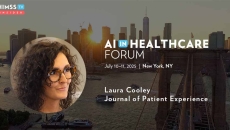clinical AI
AI can be used as a tool to provide patients and their families with more information, faster access and more affordable care, says Laura Cooley, editor in chief of the Journal of Patient Experience.
Event attendees explored the challenges and benefits of AI while learning about governance, leadership strategy, workforce challenges, transparency, patient safety and data security at the gathering in Brooklyn, New York.
Ernst & Young Health AI and Data Leader Sezin Palmer advises, among other things, to be strategic and selective, build with value and scale in mind, retool available talent, and work with consultants and vendors effectively.
Banner Health built an in-house, enterprise class digital assistant that helps team members with typical tasks that they might use AI on such as summarizing a long document, getting insight or planning, says CTO Mike Reagin.
AI helps reduce time spent in chart search, review and prep enabling end users to see a quick AI generated summary highlighting the most important things that need to be addressed, says Lori Walker, Presbyterian Healthcare Services' CMIO.
Different types of artificial intelligence help mirror clinical judgement and deliver real-time insights across the areas of the mid-revenue cycle, specifically utilization management, clinical documentation and coding, says William Chan, cofounder and CEO of Iodine Software.
HIMSS25
While robust data governance will be required to ensure trustworthiness and compliance, Velatura Public Benefit Corporation's Prashant Natarajan believes that in 2026, AI will help more providers empower, engage and educate patients.
HIMSS25
Penn Medicine's Anna Schoenbaum says the HIMSS Nursing Innovation Advisory Workgroup, which she co-chairs, has developed AI toolkits and customizable teaching slides to help leaders understand AI's complexity, costs and impact.
HIMSS25
Nicole Rogas, RevSpring president, says health systems can improve the billing experience and collect more revenue by using AI and data analytics to create personalized messages delivered via patients' preferred contact methods.
HIMSS25
AI tools can personalize patients' searches for providers, but Kyruus Health's Gen Conlin believes nurse informaticists' ability to ensure tool accessibility and accuracy are vital to ensuring patients find the right care.









